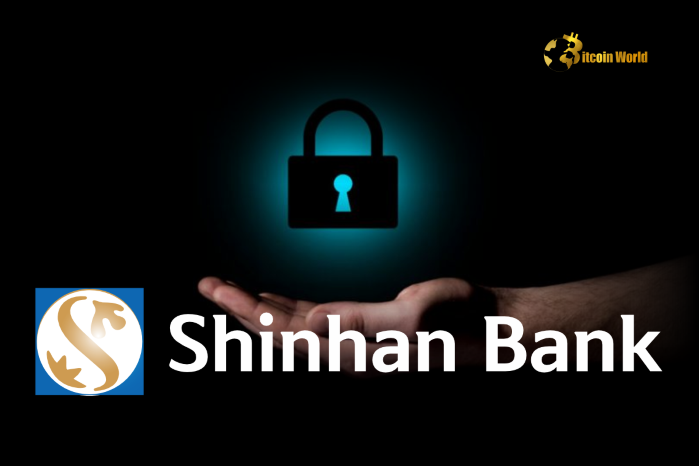The winds of change are blowing strongly in South Korea’s financial sector, and cryptocurrency is at the heart of it. Leading the charge, Shinhan Bank is making headlines with a significant capital injection into Korea Digital Asset Custody (KDAC). This strategic maneuver isn’t just about one bank; it’s a powerful signal of a larger trend – Korean banks are seriously stepping into the realm of crypto custody. Let’s dive deep into this exciting development and understand what it means for the future of digital assets.
Why are Korean Banks Rushing into Crypto Custody?
For years, traditional banks and the cryptocurrency world seemed like distant planets. However, the undeniable growth and increasing institutional interest in digital assets have created a gravitational pull. Korean banks, known for their forward-thinking approach, are recognizing the immense potential and necessity of offering crypto custody services. But why now? Here are a few compelling reasons:
- Growing Market Demand: As more individuals and institutions in South Korea explore cryptocurrencies, the demand for secure and regulated crypto custody solutions is skyrocketing. Banks are naturally positioned to meet this demand, leveraging their existing trust and infrastructure.
- Regulatory Clarity (Sort Of): While the regulatory landscape for crypto is still evolving globally, South Korea has been proactively shaping its approach. This provides a degree of clarity and encourages established financial institutions to explore crypto-related services with more confidence.
- Competitive Pressure: With fintech companies and specialized crypto firms already offering custody solutions, Korean banks face competitive pressure to enter this space and avoid being left behind in the digital asset revolution.
- Revenue Opportunities: Crypto custody is not just about keeping digital assets safe; it’s a revenue-generating service. Banks can charge fees for custody, staking, and other related services, adding a new income stream in a potentially lucrative market.
- Client Retention and Expansion: Offering crypto custody allows Korean banks to cater to the evolving needs of their existing clients and attract new customers who are actively involved in the crypto market.
Shinhan Bank’s KDAC Investment: A Deeper Dive into Digital Asset Custody
Shinhan Bank’s move to pump 1 billion won ($695,000) into KDAC is more than just a financial transaction; it’s a strategic endorsement of crypto custody. KDAC, or Korea Digital Asset Custody, is a key player in the South Korean digital asset space. Shinhan Bank’s increased stake signals a strong belief in KDAC’s potential and the broader crypto custody market. Let’s break down the significance:
- Capital Boost for KDAC: The 1 billion won infusion will provide KDAC with the necessary capital to enhance its infrastructure, expand its services, and strengthen its position in the competitive crypto custody landscape.
- Shinhan Bank’s Commitment: This investment demonstrates Shinhan Bank’s serious commitment to the digital asset sector. It’s not just dipping a toe in the water; it’s making a deliberate stride into the crypto custody arena.
- Validation of KDAC’s Business Model: Shinhan Bank’s further investment in KDAC serves as a strong validation of KDAC’s business model and its potential for growth in the crypto custody market.
- Broader Trend Confirmation: This move, alongside Nonghyup Bank’s prior investment in KDAC, reinforces the trend of traditional Korean banks embracing crypto custody. It’s not an isolated incident but part of a larger industry shift.
Beyond Shinhan: A Nation-Wide Crypto Custody Trend Among Korean Banks
Shinhan Bank isn’t alone in this journey. The article rightly points out that other major Korean banks are also actively engaging with crypto custody, albeit through different approaches. This collective movement underscores the industry-wide recognition of digital assets and the necessity for secure custody solutions. Let’s examine how other banks are participating:
| Korean Bank | Crypto Custody Initiative | Partners/Collaborators |
|---|---|---|
| KB Kookmin Bank | Korea Digital Asset (KODA) | Haechi Labs (Blockchain Developer) |
| Hana Bank | Partnership | BitGo Korea (Digital Asset Trust Company) |
| Woori Bank | Partnership | BDACS |
| Nonghyup Bank | Investment in KDAC | KDAC |
| Shinhan Bank | Increased Investment in KDAC | KDAC |
Korean Banks and Their Crypto Custody Ventures
This table clearly illustrates that Korean banks are adopting diverse strategies to enter the crypto custody market. Some are creating in-house solutions (like KB Kookmin Bank with KODA), while others are opting for strategic partnerships with established crypto firms. Regardless of the approach, the underlying message is consistent: crypto custody is becoming an integral part of the Korean banking landscape.
What are the Benefits of Crypto Custody for Korean Banks and the Market?
The move by Korean banks into crypto custody offers a range of benefits, not just for the banks themselves but for the broader cryptocurrency ecosystem and investors:
- Enhanced Security and Trust: Banks are synonymous with security and trust. Their entry into crypto custody brings a higher level of security and regulatory oversight to the digital asset space, fostering greater trust among investors.
- Institutional Adoption Catalyst: The involvement of established Korean banks can act as a catalyst for further institutional adoption of cryptocurrencies. Institutions are more likely to invest in digital assets when they can rely on reputable banks for secure custody solutions.
- Mainstream Accessibility: Banks can bridge the gap between traditional finance and the crypto world, making digital assets more accessible to a wider audience, including retail investors who are comfortable dealing with banks.
- Market Maturation: The participation of Korean banks contributes to the overall maturation of the cryptocurrency market. It signifies a move towards greater legitimacy and integration with the mainstream financial system.
- Innovation and Competition: Increased competition in the crypto custody space, driven by bank involvement, can spur innovation and lead to better services and potentially lower fees for customers.
Navigating the Challenges of Crypto Custody in South Korea
While the foray of Korean banks into crypto custody is promising, it’s not without its challenges. These institutions need to navigate a complex landscape that includes:
- Regulatory Uncertainty: Despite progress, the regulatory framework for cryptocurrencies is still evolving in South Korea and globally. Banks need to remain adaptable and compliant with changing regulations.
- Technological Complexity: Crypto custody requires specialized technological expertise in blockchain and cybersecurity. Banks need to invest in building or acquiring the necessary technological capabilities.
- Security Risks: Digital assets are vulnerable to cyberattacks. Banks must implement robust security measures to protect against hacking and theft, exceeding even traditional banking security standards.
- Operational Challenges: Managing crypto custody operations, including key management, transaction processing, and reporting, can be complex and require new operational frameworks.
- Public Perception and Education: Banks need to educate both their staff and customers about crypto custody and address any lingering skepticism or misconceptions about digital assets.
Actionable Insights: What Does This Mean for the Future of Digital Assets?
The actions of Korean banks are a strong indicator of the direction the financial industry is heading. Here are some key takeaways and actionable insights:
- Crypto Custody is Becoming Mainstream: The entry of traditional banks into crypto custody signifies that digital assets are no longer a fringe phenomenon but are moving firmly into the mainstream financial system.
- Increased Institutional Investment is Likely: As secure and regulated crypto custody solutions become more readily available through banks, we can expect to see increased institutional investment in cryptocurrencies.
- South Korea as a Crypto Hub: South Korea is positioning itself as a leading hub for cryptocurrency innovation and adoption, with its proactive regulatory approach and the engagement of its major banks.
- Opportunity for Crypto Businesses: This trend creates opportunities for crypto-related businesses to collaborate with banks and develop innovative financial products and services around digital assets.
- Focus on Security and Compliance: For anyone involved in the crypto custody space, the emphasis on security, regulatory compliance, and building trust will be paramount for success.
Conclusion: A New Chapter for Crypto and Traditional Finance
Shinhan Bank’s capital boost for KDAC is more than just a news item; it’s a symbol of the evolving relationship between traditional finance and the world of cryptocurrency. The eagerness of Korean banks to embrace crypto custody demonstrates a significant shift in perception and strategy. This bold move signals a new chapter, one where digital assets are not just tolerated but actively integrated into the established financial framework. As Korean banks pave the way, we can anticipate further developments and a deepening convergence between the traditional and crypto financial ecosystems, promising exciting opportunities and transformations in the years to come. The digital asset revolution is underway, and Korean banks are strategically positioning themselves at the forefront.
To learn more about the latest crypto market trends, explore our article on key developments shaping Bitcoin price action.






